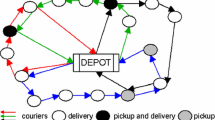Abstract
In this paper a discrete location model for non-essential service facilities planning is described, which seeks the number, location, and size of facilities, that maximizes the total expected demand attracted by the facilities. It is assumed that the demand for service is sensitive to the distance from facilities and to their size. It is also assumed that facilities must satisfy a threshold level of demand (facilities are not economically viable below that level). A Mixed-Integer Nonlinear Programming (MINLP) model is proposed for this problem. A branch-and-bound algorithm is designed for solving this MINLP and its convergence to a global minimum is established. A finite procedure is also introduced to find a feasible solution for the MINLP that reduces the overall search in the binary tree generated by the branch-and-bound algorithm. Some numerical results using a GAMS/MINOS implementation of the algorithm are reported to illustrate its efficacy and efficiency in practice.
Similar content being viewed by others
References
Daskin, M.: Network and Discrete Location: Models, Algorithms and Applications. Wiley, New York (1995)
Current, J., Daskin, M., Schilling, D.: Discrete network location models. In: Facility Location: Applications and Theory, pp. 81–118 (2002)
Holmberg, K.: Facility location problems with spatial interaction. In: Floudas, C.A., Pardalos, P.M. (eds.), Encyclopedia of Optimization, 2nd edn., pp. 982–989. Springer, Berlin (2009)
ReVelle, C., Eiselt, H.: Location analysis: A synthesis and survey. Eur. J. Oper. Res. 165(1), 1–19 (2005)
Tuy, H.: Global optimization in location problems. In: Floudas, C.A., Pardalos, P.M. (eds.), Encyclopedia of Optimization, 2nd edn., pp. 1354–1359. Springer, Berlin (2009)
Krarup, J., Pruzan, P.M.: Simple plant location problem: Survey and synthesis. Eur. J. Oper. Res. 12(1), 36–81 (1983)
Mirchandani, P.: The p-median problem and generalizations. In: Mirchandani, P., Francis, R. (eds.) Discrete Location Theory, vol. 1, pp. 55–117. Wiley, New York (1990)
Perl, J., Ho, P.: Public facilities location under elastic demand. Transp. Sci. 24(2), 117–136 (1990)
OKelly, M.: Spatial interaction based location-allocation models. In: Spatial Analysis and Location-Allocation Models, pp. 302–326. van Nostrand, Princeton (1987)
Eiselt, H., Laporte, G.: The maximum capture problem in a weighted network. J. Reg. Sci. 29(3), 433–439 (1989)
Plastria, F., Carrizosa, E.: Optimal location and design of a competitive facility. Math. Program. 100(2), 247–265 (2004)
Berman, O., Krass, D.: Locating multiple competitive facilities: spatial interaction models with variable expenditures. Ann. Oper. Res. 111(1), 197–225 (2002)
Aboolian, R., Berman, O., Krass, D.: Competitive facility location and design problem. Eur. J. Oper. Res. 182(1), 40–62 (2007)
Sahinidis, N., Tawarmalani, M.: BARON: The GAMS Solver Manual, pp. 9–20. GAMS Development Corporation, Washington (2004)
Cascetta, E.: Transportation Systems Analysis: Models and Applications, 2nd edn. Springer, Berlin (2009)
Bazaraa, M.S., Sherali, H.D., Shetty, C.M.: Nonlinear programming: theory and algorithms, 3rd edn. Wiley-Interscience, New York (2006)
Murtagh, B., Saunders, M., Murray, W., Gill, P., Raman, R., Kalvelagen, E.: MINOS-NLP. Systems Optimization Laboratory. Stanford University, Palo Alto
Brooke, A., Kendrick, D., Meeraus, A., Raman, R.: GAMS—A user’s guide. GAMS Development Corporation, Washington (1998)
CPLEX, I.: 11.0 Users Manual. ILOG SA, Gentilly (2008)
Author information
Authors and Affiliations
Corresponding author
Additional information
Communicated by P.M. Pardalos.
This research is supported in part by the National Science Foundation, under Grant Number CMMI-0969169.
Rights and permissions
About this article
Cite this article
Fernandes, L.M., Júdice, J.J., Sherali, H.D. et al. Siting and Sizing of Facilities under Probabilistic Demands. J Optim Theory Appl 158, 284–304 (2013). https://doi.org/10.1007/s10957-010-9789-8
Published:
Issue Date:
DOI: https://doi.org/10.1007/s10957-010-9789-8




